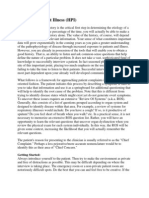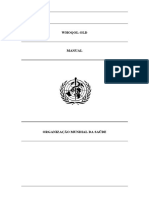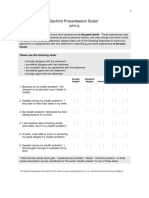Escala Garf
Escala Garf
Uploaded by
Ana Claudia PoiteCopyright:
Available Formats
Escala Garf
Escala Garf
Uploaded by
Ana Claudia PoiteCopyright
Available Formats
Share this document
Did you find this document useful?
Is this content inappropriate?
Copyright:
Available Formats
Escala Garf
Escala Garf
Uploaded by
Ana Claudia PoiteCopyright:
Available Formats
Global Assessment of Functioning (GAF) Scale
(From DSM-IV-TR, p. 34.)
Consider psychological, social, and occupational functioning on a hypothetical continuum of mental health-illness. Do not include impairment in functioning due to physical (or environmental) limitations.
Code 100 | 91 90 | 81 80 | 71 70 | 61 60 | 51 50 | 41 (Note: Use intermediate codes when appropriate, e.g., 45, 68, 72.) Superior functioning in a wide range of activities, lifes problems never seem to get out of hand, is sought out by others because of his or her many positive qualities. No symptoms. Absent or minimal symptoms (e.g., mild anxiety before an exam), good functioning in all areas, interested and involved in a wide range of activities. socially effective, generally satisfied with life, no more than everyday problems or concerns (e.g. an occasional argument with family members). If symptoms are present, they are transient and expectable reactions to psychosocial stressors (e.g., difficulty concentrating after family argument); no more than slight impairment in social, occupational or school functioning (e.g., temporarily failing behind in schoolwork). Some mild symptoms (e.g. depressed mood and mild insomnia) OR some difficulty in social, occupational, or school functioning (e.g., occasional truancy, or theft within the household), but generally functioning pretty well, has some meaningful interpersonal relationships. Moderate symptoms (e.g., flat affect and circumstantial speech, occasional panic attacks) OR moderate difficulty in social, occupational, or school functioning (e.g.. few friends, conflicts with peers or co-workers). Serious symptoms (e.g.. suicidal ideation, severe obsessional rituals, frequent shoplifting) OR any serious impairment in social, occupational, or school functioning (e.g., no friends, unable to keep a job). Some impairment in reality testing or communication (e.g., speech is at times illogical, obscure, or irrelevant) OR major impairment in several areas, such as work or school, family relations, judgment, thinking, or mood (e.g., depressed man avoids friends, neglects family, and is unable to work; child frequently beats up younger children, is defiant at home, and is failing at school). Behavior is considerably influenced by delusions or hallucinations OR serious impairment in communication or judgment (e.g., sometimes incoherent, acts grossly inappropriately, suicidal preoccupation) OR inability to function in almost all areas (e.g., stays in bed all day; no job, home, or friends). Some danger of hurting self or others (e.g., suicide attempts without clear expectation of death; frequently violent; manic excitement) OR occasionally fails to maintain minimal personal hygiene (e.g., smears feces) OR gross impairment in communication (e.g., largely incoherent or mute). Persistent danger of severely hurting self or others (e.g., recurrent violence) OR persistent inability to maintain minimal personal hygiene OR serious suicidal act with clear expectation of death. Inadequate information.
40 | 31
30 | 21
20 | 11 10 | 1 0
You might also like
- (Practical Resources for the Mental Health Professional) Sharon L. Johnson-Therapist's Guide to Clinical Intervention, Second Edition_ The 1-2-3's of Treatment Planning (Practical Resources for the Me(1).pdfDocument594 pages(Practical Resources for the Mental Health Professional) Sharon L. Johnson-Therapist's Guide to Clinical Intervention, Second Edition_ The 1-2-3's of Treatment Planning (Practical Resources for the Me(1).pdfNgọcLong Phạm100% (8)
- Scales of Independent Behavior-RevisedDocument1 pageScales of Independent Behavior-RevisedclNo ratings yet
- Global Assessment FunctioningDocument8 pagesGlobal Assessment FunctioningWimbi Kartika RatnasariNo ratings yet
- SCAAREDAdultVersion 1.19.18 PDFDocument3 pagesSCAAREDAdultVersion 1.19.18 PDFVirvara DanielaNo ratings yet
- Abas II Jan 2012Document5 pagesAbas II Jan 2012Luísa Teixeira0% (1)
- Binge Eating Scale BES PDFDocument1 pageBinge Eating Scale BES PDFSînziana EnescuNo ratings yet
- Brief ManualDocument9 pagesBrief ManualPablo Abel Gil SotoNo ratings yet
- Global Assessment FunctioningDocument8 pagesGlobal Assessment Functioningalin67100% (1)
- History of Present IllnessDocument10 pagesHistory of Present Illnesshirsi200518No ratings yet
- Mr. JonesDocument2 pagesMr. JonesFuture RN100% (2)
- Neuro Developmental DisordersDocument59 pagesNeuro Developmental Disorderskgaseitsiwe0952No ratings yet
- APSR-English Almost Perfect ScaleDocument2 pagesAPSR-English Almost Perfect Scaleshaguftashabba136No ratings yet
- The Strengths and Difficulties Questionnaire (SDQ)Document2 pagesThe Strengths and Difficulties Questionnaire (SDQ)Carla HortaNo ratings yet
- Young's Schema Questionnaire - Short Form Version 3 (YSQ-S3) : Preliminary Validation in Older AdultsDocument35 pagesYoung's Schema Questionnaire - Short Form Version 3 (YSQ-S3) : Preliminary Validation in Older AdultsFiona DayNo ratings yet
- Test of Word Reading Efficiency (TOWRE)Document6 pagesTest of Word Reading Efficiency (TOWRE)lisayaaaah0327No ratings yet
- WHOQOL-OLD Manual POrtuguesDocument19 pagesWHOQOL-OLD Manual POrtuguesPEDRO MENDES MACIELNo ratings yet
- Formulario para Comprar Material Del Sistema de Evaluación Empírica de Achenbach 2020Document7 pagesFormulario para Comprar Material Del Sistema de Evaluación Empírica de Achenbach 2020IliMonteroNo ratings yet
- Link To Publication in University of Groningen/UMCG Research DatabaseDocument19 pagesLink To Publication in University of Groningen/UMCG Research Databaseovr79100% (1)
- My Relationship With My FatherDocument2 pagesMy Relationship With My FatherEspíritu CiudadanoNo ratings yet
- Finger Tapping TestDocument4 pagesFinger Tapping Test6002-mcp-s23No ratings yet
- Barrat ColombiaDocument18 pagesBarrat ColombiaAntorcha CA100% (1)
- Eyes Test (Baron Cohen Et Al)Document5 pagesEyes Test (Baron Cohen Et Al)nico.cassany7No ratings yet
- IVA 2 Detailed ReportDocument5 pagesIVA 2 Detailed ReportmohammadzarekandejaniNo ratings yet
- Alcohol-Dependence-Scale ADSDocument4 pagesAlcohol-Dependence-Scale ADSRick dangerNo ratings yet
- Eyberg Child Behavior Inventory (ECBI) : 36-Item Parent Report of 2-16-Year-OldsDocument8 pagesEyberg Child Behavior Inventory (ECBI) : 36-Item Parent Report of 2-16-Year-OldsGiiszs AlvarezNo ratings yet
- SRCATDocument2 pagesSRCATLuana Cunha FerreiraNo ratings yet
- Self-Efficacy in The Primary ClassroomDocument17 pagesSelf-Efficacy in The Primary ClassroomKara AzzaNo ratings yet
- Scoff-Questionnaire BookDocument1 pageScoff-Questionnaire BookAbhilash AttriNo ratings yet
- Toulouse Pieron Cancellation Test Normative Scores For The Portuguese PopulationDocument8 pagesToulouse Pieron Cancellation Test Normative Scores For The Portuguese PopulationHelping OthersNo ratings yet
- GudjonssonDocument2 pagesGudjonssonapplefaceNo ratings yet
- BIS 11 InglesDocument5 pagesBIS 11 InglesNatalia MoralesNo ratings yet
- Sample: State-Trait Anger Expression Inventory™ Interpretive Report (STAXI-2: IR™)Document12 pagesSample: State-Trait Anger Expression Inventory™ Interpretive Report (STAXI-2: IR™)Uso MediasNo ratings yet
- Problem Behavior QuestionnaireDocument1 pageProblem Behavior QuestionnaireHarry Jr.No ratings yet
- Clinical Outcomes in Routine Evaluation CORE OMDocument3 pagesClinical Outcomes in Routine Evaluation CORE OMkhadija khokhawalaNo ratings yet
- SPS 6Document1 pageSPS 6Hendra TPNo ratings yet
- Whodas EnglishDocument14 pagesWhodas EnglishJorge Reyes ManzanoNo ratings yet
- Y BocsDocument1 pageY BocsAnonymous KgUtPlkjNo ratings yet
- The Employees Provident Fund and Miscellaneous Provisions Act, 1952Document2 pagesThe Employees Provident Fund and Miscellaneous Provisions Act, 1952tarkdeepڪNo ratings yet
- Gifted Development Center: Early Signs of GiftednessDocument7 pagesGifted Development Center: Early Signs of GiftednessaizawachoiNo ratings yet
- The Cornell Scale For Depression in DementiaDocument12 pagesThe Cornell Scale For Depression in DementiaPopa NiculinaNo ratings yet
- A Psychological Assessment: Developed by Zimet, G.D., Et. Al (1988)Document1 pageA Psychological Assessment: Developed by Zimet, G.D., Et. Al (1988)Raj RamNo ratings yet
- Dass 42Document2 pagesDass 42mail4079No ratings yet
- The New Handbook of Cognitive Therapy Techniques - Rian E - McMullin - Norton Professional BooksDocument520 pagesThe New Handbook of Cognitive Therapy Techniques - Rian E - McMullin - Norton Professional BooksCarlotaNo ratings yet
- Troke Specific Quality of Life Scale (SS-QOL) : EnergyDocument2 pagesTroke Specific Quality of Life Scale (SS-QOL) : EnergyBayu WirantikaNo ratings yet
- Brown - Adhd - Scales DescriptionDocument2 pagesBrown - Adhd - Scales DescriptionJohn SteppenwolfNo ratings yet
- Bender Visual Motor Gestalt TestDocument2 pagesBender Visual Motor Gestalt TestMaheenNo ratings yet
- Emotional Regulation QuestionnaireDocument11 pagesEmotional Regulation QuestionnaireSehrishKhanNo ratings yet
- Resilience Assessment Questionnaire 2019Document3 pagesResilience Assessment Questionnaire 2019anirudh raghunathNo ratings yet
- Pops Test ResultsDocument3 pagesPops Test ResultsDana MobayedNo ratings yet
- Personality in AdulthoodDocument79 pagesPersonality in AdulthoodcarolinasgarofaloNo ratings yet
- Leiter 3 Manual Corrections UpdatesDocument10 pagesLeiter 3 Manual Corrections UpdatesDidenko MarinaNo ratings yet
- Artigo NeuropsicológicoDocument22 pagesArtigo NeuropsicológicoSamanta FariasNo ratings yet
- K.US CDC Developmental Milestones ChecklistDocument20 pagesK.US CDC Developmental Milestones Checklistbai yhang de la cruzNo ratings yet
- 3 Current Thematic Apperception Tests For ChildDocument31 pages3 Current Thematic Apperception Tests For ChildAdriánMadrigal100% (1)
- CGASDocument4 pagesCGASDinny Atin AmanahNo ratings yet
- Neuropsychological Assessment Clinial InterviewDocument11 pagesNeuropsychological Assessment Clinial Interviewsophielewis121No ratings yet
- PROMIS Social Isolation Scoring ManualDocument7 pagesPROMIS Social Isolation Scoring ManualMonica ArleguiNo ratings yet
- MBTI (Myers - Briggs Type Indicator)Document6 pagesMBTI (Myers - Briggs Type Indicator)Sayantan RoyNo ratings yet
- Associations Between 24 Hour Movement Behaviours and Global Cognition in US Children - A Cross-Sectional Observational StudyDocument9 pagesAssociations Between 24 Hour Movement Behaviours and Global Cognition in US Children - A Cross-Sectional Observational StudyniNo ratings yet
- WISC (Wechsler Intelligence Scale For Children)Document5 pagesWISC (Wechsler Intelligence Scale For Children)naziaimam62No ratings yet
- Skala GafDocument1 pageSkala GafRamya HarlistyaNo ratings yet
- Global Assessment of FunctioningDocument1 pageGlobal Assessment of FunctioningKen Carter100% (2)
- Global Assessment of Functioning ScaleDocument1 pageGlobal Assessment of Functioning ScaleLucasCoutoNo ratings yet
- GAD708 19 08cartwright PDFDocument1 pageGAD708 19 08cartwright PDFIrfan FauziNo ratings yet
- Organization and DevelopmentDocument33 pagesOrganization and DevelopmentJoanna GadiaNo ratings yet
- Delirium 5Document4 pagesDelirium 5lalitrajindoliaNo ratings yet
- Lembar Jawaban Skill Lab Evidence Based Medicine Tanggal 23 Mei 2017Document21 pagesLembar Jawaban Skill Lab Evidence Based Medicine Tanggal 23 Mei 2017Jennifer FinnaliaNo ratings yet
- Diagnostic Radiology Blueprint_2024Document5 pagesDiagnostic Radiology Blueprint_2024رمضان كريمNo ratings yet
- Dizziness - PPPD Information SheetDocument8 pagesDizziness - PPPD Information Sheettan_siqi100% (1)
- Dissertation GuidelinesDocument9 pagesDissertation Guidelinesrejipg86% (7)
- Kahn Test For Shipilis PDFDocument4 pagesKahn Test For Shipilis PDFUmi KalsumNo ratings yet
- Mary C. Gomez, MD, DPBP, FPPA Child, Adolescent, Adult PsychiatristDocument66 pagesMary C. Gomez, MD, DPBP, FPPA Child, Adolescent, Adult Psychiatristxiejie22590No ratings yet
- 1) Diagnostic and Remedial TeachingDocument12 pages1) Diagnostic and Remedial TeachingAnonymous 1kYu43dCZ100% (1)
- GROUP 10-Clinical Decision Support SystemDocument25 pagesGROUP 10-Clinical Decision Support Systemsameer.hamdanNo ratings yet
- AAC - 2 - Registration & Admission - FinalDocument16 pagesAAC - 2 - Registration & Admission - Finalams.khn.2024No ratings yet
- On Virtual Doctor System For Health Monitoring FinalDocument23 pagesOn Virtual Doctor System For Health Monitoring FinalChetu ChethanNo ratings yet
- Patient Health QuestionnaireDocument12 pagesPatient Health QuestionnaireumibrahimNo ratings yet
- Sample Report 8th-Sem E11287Document91 pagesSample Report 8th-Sem E11287Rahul SharmaNo ratings yet
- Chapter 17 Mood Disorders and SuicideDocument13 pagesChapter 17 Mood Disorders and Suicidemyer pasandalanNo ratings yet
- The Path To Addiction: Stages of AlcoholismDocument3 pagesThe Path To Addiction: Stages of AlcoholismAsmaa LabibNo ratings yet
- Nursing Foundation Course OutlineDocument17 pagesNursing Foundation Course OutlineTenIs ForMeNo ratings yet
- Bmed Concept MapDocument2 pagesBmed Concept Mapapi-247954649No ratings yet
- Ged Test Accom App AdhdDocument7 pagesGed Test Accom App AdhdJeannette DorfmanNo ratings yet
- Understanding Dissociative Disorders 2016 PDFDocument28 pagesUnderstanding Dissociative Disorders 2016 PDFKris Grimstad100% (1)
- CBTDocument1 pageCBTdlacs91100% (1)
- A Systematic Review On Artificial Intelligence ForDocument20 pagesA Systematic Review On Artificial Intelligence ForblueyoonvNo ratings yet
- Delusion and Hallucination Final NewDocument15 pagesDelusion and Hallucination Final NewRashmi Hanna NormanNo ratings yet
- Hierarchical Reinforcement Learning - A Comprehensive SurveyDocument6 pagesHierarchical Reinforcement Learning - A Comprehensive SurveySuren DevNo ratings yet
- Poster - Estupiñan AndryDocument1 pagePoster - Estupiñan Andryandryese98No ratings yet
- Course Plan MSNDocument27 pagesCourse Plan MSNSanthosh.S.UNo ratings yet

























































































